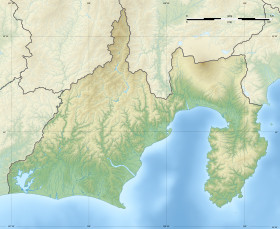
Back Foedji Afrikaans ፉጂ ተራራ Amharic Fucgi Beorg ANG جبل فوجي Arabic جبل فوجى ARZ মাউণ্ট ফুজি Assamese Monte Fuji AST Fuci Azerbaijani فوجییاما AZB Фудзияма Bashkir
| Mount Fuji | |
|---|---|
 Mount Fuji seen from Ōwakudani | |
| Highest point | |
| Prominence | 3,776 m (12,388 ft)[1] Ranked 35th |
| Listing | |
| Coordinates | 35°21′39″N 138°43′39″E / 35.36083°N 138.72750°E[2] |
| Naming | |
| Native name | 富士山 (Japanese) |
| Pronunciation | [ɸɯꜜ(d)ʑisaɴ] |
| Geography | |
| Location | Fuji-Hakone-Izu National Park |
| Country | Japan |
| Prefectures | Shizuoka and Yamanashi |
| Municipalities | Fuji, Fujinomiya, Fujiyoshida, Gotemba, Narusawa and Oyama |
| Topo map | Geospatial Information Authority 25000:1 富士山[3] 50000:1 富士山 |
| Geology | |
| Age of rock | 100,000 years |
| Mountain type | Stratovolcano |
| Last eruption | 1707–08 |
| Climbing | |
| First ascent | 663 by En no Odzunu (役行者, En no gyoja, En no Odzuno) |
| Easiest route | Hiking |
| Official name | Fujisan, sacred place and source of artistic inspiration |
| Criteria | Cultural: iii, vi |
| Reference | 1418 |
| Inscription | 2013 (37th Session) |
| Area | 20,702.1 ha |
| Buffer zone | 49,627.7 ha |
| Mount Fuji | |||||
|---|---|---|---|---|---|
"Mt. Fuji" in kanji | |||||
| Japanese name | |||||
| Kanji | 富士山 | ||||
| |||||
Mount Fuji (富士山, Fujisan, Japanese: [ɸɯꜜ(d)ʑisaɴ] ) is an active stratovolcano located on the Japanese island of Honshu, with a summit elevation of 3,776.24 m (12,389 ft 3 in). It is the tallest mountain in Japan, the second-highest volcano located on an island in Asia (after Mount Kerinci on the Indonesian island of Sumatra), and seventh-highest peak of an island on Earth.[1] Mount Fuji last erupted from 1707 to 1708.[4][5] The mountain is located about 100 km (62 mi) southwest of Tokyo and is visible from the Japanese capital on clear days. Mount Fuji's exceptionally symmetrical cone, which is covered in snow for about five months of the year, is commonly used as a cultural icon of Japan and is frequently depicted in art and photography, as well as visited by sightseers, hikers and mountain climbers.[6]
Mount Fuji is one of Japan's "Three Holy Mountains" (三霊山, Sanreizan) along with Mount Tate and Mount Haku. It is a Special Place of Scenic Beauty and one of Japan's Historic Sites.[7] It was added to the World Heritage List as a Cultural Site on June 22, 2013.[7] According to UNESCO, Mount Fuji has "inspired artists and poets and been the object of pilgrimage for centuries". UNESCO recognizes 25 sites of cultural interest within the Mount Fuji locality. These 25 locations include the mountain and the Shinto shrine, Fujisan Hongū Sengen Taisha.[8]
- ^ a b Cite error: The named reference
Fujiinfowas invoked but never defined (see the help page). - ^ "Nihon no omona sangaku" 日本の主な山岳 [Japan's main mountains] (in Japanese). Geospatial Information Authority of Japan. Retrieved November 17, 2023.
- ^ Cite error: The named reference
watch tizuwas invoked but never defined (see the help page). - ^ Cite error: The named reference
GSJ_activewas invoked but never defined (see the help page). - ^ Cite error: The named reference
Britannicawas invoked but never defined (see the help page). - ^ Scheffel, Richard L.; Wernet, Susan J., eds. (1980). Natural Wonders of the World. United States: Reader's Digest Association. p. 153. ISBN 0-89577-087-3.
- ^ a b "Japan's Mt. Fuji granted World Heritage status". CNA. June 22, 2013. Archived from the original on June 27, 2013.
- ^ Centre, UNESCO World Heritage. "Fujisan, sacred place and source of artistic inspiration". UNESCO World Heritage Centre. Archived from the original on October 17, 2022. Retrieved February 11, 2022.
© MMXXIII Rich X Search. We shall prevail. All rights reserved. Rich X Search

